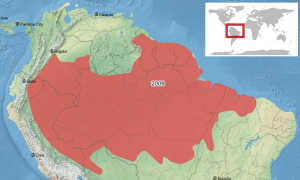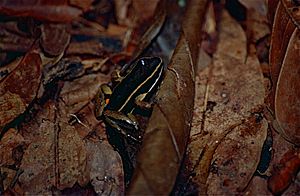Allobates femoralis facts for kids
Quick facts for kids Allobates femoralis |
|
|---|---|
 |
|
| Conservation status | |
| Scientific classification | |
| Genus: |
Allobates
|
| Species: |
femoralis
|
 |
|
| Distribution map of Allobates femoralis | |
The brilliant-thighed poison frog (Allobates femoralis) is a small, colorful frog that lives in the rainforests of South America. It's part of the Aromobatidae family of frogs. Even though it's called a "poison frog," it's not as dangerous as some other poison dart frogs. It's found in many countries, including Bolivia, Brazil, Colombia, Ecuador, French Guiana, Guyana, Peru, and Suriname.
Contents
Meet the Brilliant-Thighed Poison Frog
Allobates femoralis is a small frog. Male frogs grow to about 2.8 to 3.3 centimeters (about 1.1 to 1.3 inches) long. Female frogs are usually a little bit bigger.
What Does It Look Like?
These frogs have a dark brown or black color on their backs and legs. Their throats are black, and their bellies are white with black marks. They have a light brown stripe that goes from their nose to their legs. There's also a white line that runs along their sides. A special feature is an orange-yellow spot behind their front legs. They also have a half-moon shaped orange patch on the outside of their thighs. This bright patch gives them their name, "brilliant-thighed."
Where Do These Frogs Live?
The brilliant-thighed poison frog lives in the Amazon basin and the tropical eastern parts of South America. You can find them in countries like Guyana, Suriname, French Guiana, and Brazil. They also live in the eastern areas of Colombia, Ecuador, Peru, and Bolivia.
Their Forest Home
These frogs prefer to live on the floor of the rainforest. They usually live in areas that are less than 300 meters (about 1,000 feet) above sea level. However, in Colombia and Ecuador, they can be found at higher places, up to 1,000 meters (about 3,300 feet) high.
How Brilliant-Thighed Poison Frogs Live
These frogs are active during the day. They spend their time on the ground in the forest.
What Do They Eat?
Allobates femoralis frogs eat small insects. Their diet includes beetles, crickets, roaches, and ants. Younger frogs, called juveniles, mostly eat tiny insects called springtails.
Frog Families: Mating and Eggs
Breeding season for these frogs is usually between November and April. It's busiest in January or February. Male frogs are very protective of their space. They try to attract females for two to three days. After this, the female lays about 8 to 17 eggs in a nest. These nests are often hidden among fallen leaves.
Courtship Dance
When a male frog sees a female, he leads her to a hidden spot to lay eggs. This spot is usually covered by dead leaves or under a log. This special behavior is called the "courtship march." The male starts the march, and the female follows him to the egg-laying spot.
A male Allobates femoralis can sometimes court more than one female. If he does, he will take turns marching with each female. The females wait patiently while he is with the other. They don't fight with each other.
Male Frog Fights
Male frogs can be aggressive with other males, especially when protecting their territory. During the "courtship march," another male might try to take the female away. This can lead to a physical fight between the males. These fights can last for about 15 minutes until one male leaves the area. It seems that seeing each other plays a big part in these male-on-male fights.
After the eggs are laid, the male stays near the female for a few minutes, then leaves. The female stays much longer, about 51 minutes, circling around the eggs.
Parental Care: Tadpole Transport
After the eggs hatch, the male frog takes care of the tadpoles. He carries them on his back to pools of water. These water spots need to be big and deep enough for the tadpoles to grow. Often, these good spots are far from the male's territory.
Long Journeys for Little Tadpoles
Males might carry tadpoles as far as 180 meters (about 590 feet) away from their home territory. The farther the water spot is, the more tadpoles the male will carry at one time. This journey takes a lot of time and effort. It means the male might lose his territory or miss chances to mate again.
Because of these long trips, Allobates femoralis frogs need a very good spatial memory. This means they are good at remembering places and directions. They can learn new routes and find the best way to transport their tadpoles. While males mostly do this, females have also been seen carrying tadpoles if their mate is gone.
After dropping off the tadpoles, the male frog needs to find his way back to his original territory. This is called "homing performance." If a male can't find his way back, it can be a big problem for his future breeding. So, having good spatial learning and a sense of direction is very important for these frogs.
Conservation Status
The IUCN (International Union for Conservation of Nature) says that Allobates femoralis is a species of "Least Concern". This is good news! It means the frog is not currently in danger of disappearing.
Why Are They "Least Concern"?
- They live in a very wide area.
- They are common in many parts of their range.
- Their numbers seem to be stable.
- Scientists haven't found any major threats to them right now.
See also
 In Spanish: Allobates femoralis para niños
In Spanish: Allobates femoralis para niños




